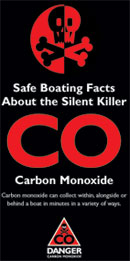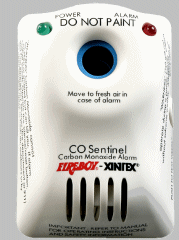Carbon Monoxide – The Silent Killer
 Carbon Monoxide poisoning can be deadly, hence CO’s nickname, “Silent Killer”. I find that most boats in my area don’t have marine quality, marine UL-listed, detectors installed. And if they are, often times they are disconnected. When I inspect detectors, I find that many have been disabled and owners report they keep going off and they’re a nuisance and must be defective. I’m not sure how they can make that assessment since carbon monoxide is not detectable by sight, smell, or any other means by the humans. The only way to know if there is a CO problem is by using a CO tester and/or a marine quality, marine UL-listed detector. It has also been reported by some folks that the CO detectors send “false” signals when upholstery and other boat building materials are out gassing. While there may be a sliver of truth to that with older type detectors, it seems counter-productive to just disconnect the detector because it is making too much noise.
Carbon Monoxide poisoning can be deadly, hence CO’s nickname, “Silent Killer”. I find that most boats in my area don’t have marine quality, marine UL-listed, detectors installed. And if they are, often times they are disconnected. When I inspect detectors, I find that many have been disabled and owners report they keep going off and they’re a nuisance and must be defective. I’m not sure how they can make that assessment since carbon monoxide is not detectable by sight, smell, or any other means by the humans. The only way to know if there is a CO problem is by using a CO tester and/or a marine quality, marine UL-listed detector. It has also been reported by some folks that the CO detectors send “false” signals when upholstery and other boat building materials are out gassing. While there may be a sliver of truth to that with older type detectors, it seems counter-productive to just disconnect the detector because it is making too much noise.
And keep in mind that if your detector alarm sounds without the engine running, it may be the exhaust (and carbon monoxide) from a nearby boat making its way to you. When an engine is initially started, very high concentrations of carbon monoxide are usually produced. This is an important thing to know since many people start their engines at the slip and run them for quite some time. Operating an engine while the boat in the slip does not put the engine under load so the engine never properly warms up and this isn’t good for the engine and it certainly can produce high levels of carbon monoxide.
Whatever the cause of the detector signaling danger, the source of the problem must be located and repairs made.
CO Facts
- Carbon Monoxide (CO) is a colorless, odorless, tasteless, toxic gas produced during the incomplete combustion of fuel, including gasoline, diesel, propane, CNG, charcoal, kerosene, wood, etc.
- Contrary to popular belief, diesel fuel produces CO.
- CO Poisoning symptoms are similar to seasickness – in fact, in the early stages of each, they ere hard to distinguish.
- Any carbon based material that is burned produces CO.
- CO poisoning and sea sickness symptoms are very similar – Don’t let people tap a nap below while the engine, generator or nearby engines are operating without proper and adequate ventilation and a properly operating CO detector.
- Your boat may not even have an engine but the boat owner next to you that operates his engines in the slip is producing CO that most likely will enter your boat – Engine or not, install a CO detector.
- Do not assume any alarm from the detector is a “false” alarm – find out why the detector is sounding the alarm!
- Human circulatory system has a strong affinity to carbon monoxide and transports it quickly through the body.
CO POISONING SYMPTOMS
- Nausea
- Fatigue
- Vomiting
- Confusion
- Death
CO EXPOSURE LIMITS
Here is what the “parts per million” concentrations of carbon monoxide mean to your health:
| 100 ppm | .01% | Slight headache in two to three hours |
| 200 ppm | .02% | Slight headache within two to three hours |
| 400 ppm | .04% | Frontal headache within one to two hours |
| 800 ppm | .08% | Dizziness, nausea, and convulsions within 45 minutes. Insensible within two hours. |
| 1,600 ppm | .16% | Headache, dizziness, and nausea within 20 minutes. Death in less than two hours. |
| 3,200 ppm | .32% | Headache, dizziness and nausea in five to ten minutes. Death within 30 minutes. |
| 6,400 ppm | .64% | Headache and dizziness in one to two minutes. Death in less than 20 minutes. |
| 12,800 ppm | 1.28% | Death in less than three minutes. |
HOW TO TREAT SUSPECTED CARBON MONOXIDE POISONING
- Evacuate, Ventilate, Investigate, Take Corrective Action – Those are the basic steps. Move the affected person to fresh air. Administer oxygen if available. Contact medical help. If the person is not breathing, perform artificial respiration as taught in Cardiopulmonary Resuscitation Training until medical help arrives. Ventilate the area. Investigate the source of carbon monoxide and make repairs.
CO SOURCES
- Any engine or appliances that burns carbon based fuels – Gasoline, Diesel, CNG (Compressed Natural Gas), LPG (Propane).
- Portable generators.
- Cabin heaters that burn diesel, wood, charcoal (highest concentrations of CO), LPG (Propane).
- Unventilated and non-marine instant type water heaters.
LOCATIONS OF POSSIBLE HIGH CONCENTRATIONS OF CO
- At helm and below deck when operating at slow speed and the cockpit, he;m, and interior have a low pressure which draws in exhaust fumes and CO.
- Swim platforms.
- Cockpits.
- Engine rooms.
- Generator spaces.
- Interior cabin spaces especially near engine compartments.
- When your moored or at anchor.
PREVENTION
- Install marine quality, marine UL-listed, carbon monoxide detectors in the accommodation spaces in your boat.
- Operate your engine room ventilation blower when idling or moving at slow speed.
- Provide adequate ventilation to the boat interior spaces.
- Do not run your engine(s) at the dock for prolonged periods of time. This is especially important when the boat engines are not warmed up or require tune-ups.
DETECTORS
Marine Quality, Marine UL-listed CO detectors are specifically made for the marine environment. The conditions that the detectors are made to operate in are often times, damp, humid, stuffy environments and as such have special sensors that can deal with such conditions. Conversely, household type detectors are for the fairly stable conditions found in most homes.
PLACARDS & LABELS
Carbon Monoxide warning labels and placards are available through many sources. Get some and post them – the life you save could be yours. The following are sources that will supply you with warning labels and placards.
DO’S & DON’TS
DON’T
- DON’T swim or sit near the swim platform when any engine is running.
- DON’T hold on to the swim platform while the boat is underway (no “Teak Surfing”).
- DON’T moor next to another boat whose engine is running.
- DON’T confuse carbon monoxide poisoning with seasickness or intoxication.
DO
- DO immediately move the person to fresh air, investigate the cause and take corrective action if someone on board complains of irritated eyes, headache, nausea, weakness or dizziness. Seek medical attention if necessary.
- DO make sure generators are properly ventilated, and keep engine and generator exhausts clear.
- DO be aware that the station wagon effect, or backdrafting, can cause carbon monoxide to accumulate inside the cabin, cockpit and bridge when the boat is underway, moving at a slow speed, or idling.
- DO keep your boat’s engine well maintained, and regularly check to make sure carbon monoxide detectors in the cabin are working properly.
- DO always wear a properly fitted life jacket while in or around water.
FURTHER INFORMATION
Please educate yourself about the dangers of this “Silent Killer”. And do install marine quality, marine UL-listed carbon monoxide detectors in your boat and home.




Comments on this entry are closed.